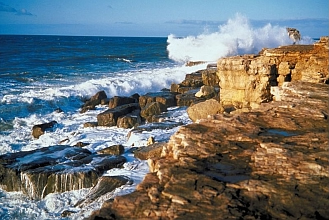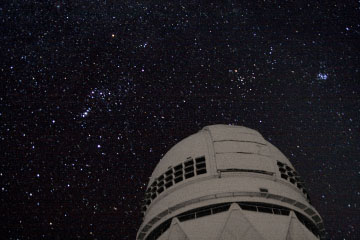The Orion constellation as seen over the Mayall 4-meter Telescope on Kitt Peak.
Credit: J. Glaspey and NOAO/AURA/NSF
International Year of Astronomy Kicks Off With Strong Support from the National Science Foundation
News story originally written on January 15, 2009
International Year of Astronomy 2009 (IYA 2009) has begun!
IYA 2009 is a celebration of astronomy and its effects on society and culture. There will be IYA2009 activities around the world!
One of the cool ways to get involved is by participating in the The Dark Skies Awareness Project, which features three citizen scientist programs: GLOBE at Night, Great World Wide Star Count, and How Many Stars. These campaigns help scientists map light pollution globally while educating participants about the stars. Each provides opportunities for you to get involved! Check out the above web sites and start observing the night sky!
The National Science Foundation, one of the main sponsors of IYA2009, is also involved in the Galileoscope Project, an official cornerstone project of IYA2009. The Galileoscope will let children make observations through a very inexpensive ($10/each) telescope. The Galileoscope is perfect for looking at bright objects like the Moon and planets.
You might also be interested in:

Scientists have learned that Mount Hood, Oregon's tallest mountain, has erupted in the past due to the mixing of two different types of magma. Adam Kent, a geologist at Oregon State University, says this
...more
The Earth's mantle is a rocky, solid shell that is between the Earth's crust and the outer core. The mantle is made up of many different reservoirs that have different chemical compositions. Scientists
...more
Some faults look strong and like they wouldn’t cause an earthquake. But it turns out that they can slip and slide like weak faults causing earthquakes. Scientists have been looking at one of these faults
...more
The sun goes through cycles that last approximately 11 years. These solar cycle include phases with more magnetic activity, sunspots, and solar flares. They also include phases with less activity. The
...more
Studying tree rings doesn't only tell us the age of that tree. Tree rings also show what climate was like while the tree was alive. This means that tree rings can tell us about climates of the past. Two
...more
Earth's first life form may have developed between the layers of a chunk of mica sitting like a multilayered sandwich in primordial waters, according to a new hypothesis. The mica hypothesis, which was
...more
Acid rain is what happens when some types of air pollution is washed out of the sky by rain. Power plants, factories, farms, houses, and cars all put pollution into the atmosphere. Sometimes, this pollution
...more















